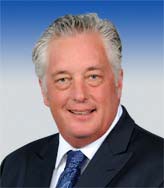The federal government is once again approaching the end of its fiscal year without the appropriations necessary to keep the doors open come October 1 — a reality that could undermine GPS modernization and related programs.
Congress, now in the midst of its August recess, will have just 12 days to sort things out when members return after Labor Day. Under the best of circumstances, lawmakers would almost certainly need to pass a continuing resolution (CR) to extend current spending levels and buy themselves time to hammer out budgetary deals.
The federal government is once again approaching the end of its fiscal year without the appropriations necessary to keep the doors open come October 1 — a reality that could undermine GPS modernization and related programs.
Congress, now in the midst of its August recess, will have just 12 days to sort things out when members return after Labor Day. Under the best of circumstances, lawmakers would almost certainly need to pass a continuing resolution (CR) to extend current spending levels and buy themselves time to hammer out budgetary deals.
But these are not the best of circumstances.
Complicating the ongoing battle over sequestration cuts and the debt ceiling is a new fight over defunding Planned Parenthood, which is in the political crosshairs after video showed its officials talking casually about the sale of tissue from aborted fetuses.
“Before the Planned Parenthood issue arose there were some extreme differences over defense and domestic spending that were likely to make it difficult to get an agreement, even to a continuing resolution, on October 1,” said Stan Collender, executive vice president and national director of financial communications at Qorvis Communications. “The Planned Parenthood situation completely complicates it because it adds that emotional take-no-prisoners issue to the mix that didn’t exist before.”
Though there have been government shutdowns previously, the Planned Parenthood issue, arising as it has during presidential primary season, makes compromise unusually difficult.
“The Planned Parenthood situation is red meat for Tea Party piranhas and it’s being debated in the midst of a campaign in which being as far right as you possibly can is a campaign event. That’s what you’ve got to do to do to get voters in primaries. It’s hard to see how Ted Cruz, Rand Paul, Lindsey Graham, or Marco Rubio can compromise on that,” said Collender.
Government Shutdown Could Recur
The situation has very practical ramifications when it comes to getting things passed in Congress, Collender explained. “With the Republicans only having 54 seats in the Senate, you lose four off the top, that means that if [Senate Majority Leader Mitch McConnell] doesn’t get a couple of Democrats to vote with him he doesn’t have a majority.”
That calculus applies to the CR, which would seem to be easier to pass, as much as to larger issues like the debt ceiling or a consolidated spending bill.
If Congress sends a continuing resolution to the president that defunds Planned Parenthood, he said, the president would veto it. “And there aren’t votes to override a veto on anything.”
Collender, a long-time budget watcher, said he thinks the Democrats will stand firm on Planned Parenthood and on the issue of not adding to defense spending without also easing strictures on domestic spending.
“I think there is a 60 percent chance of a shutdown right now — and it may be getting worse,” Collender told Inside GNSS.
The foundational nature of the disagreements and the election-saturated atmosphere, mean a shutdown this fall could last longer than previous ones. Should federal offices be closed for more than two weeks, said Collender, federal contractors will begin laying people off.
There is some good news, of a sort. Assuming the government is operating, it may not run out of money at the end of October as predicted by the U.S. Treasury Secretary Jack Lew.
The U.S. reached its debt ceiling in March and Lew has been juggling accounts to manage the crunch ever since. More precisely, the debt ceiling was reset in March to just over $18 trillion, an amount that covered what had been borrowed up to that point but no more. Congress had decided to ignore the problem for a while and suspended the debt ceiling a year earlier, but then failed to give the Treasury any room for more borrowing to keep the government running.
Officials have been exercising “extraordinary measures” since March — that is, using legal accounting tricks to keep the bills paid until Congress steps up. These maneuvers successfully extended the government’s ability to operate, as has an unexpected influx of revenue. That extra income helped pushed the date for budgetary disaster past the end of October to as late as November or December according to the Bipartisan Policy Center (BPC), at which point raising the debt ceiling becomes another issue for Congress to deal with.
Ramifications for Other GPS Initiatives
How a shutdown or CR might affect the GPS program remains unclear, although some negative consequences appear likely.
Air Force Space Command, for example, said in July that it intended to award the GPS III Phase 1 Production Readiness Feasibility Assessment contract in the second quarter of fiscal year 2016. The contracting process could be slowed by a shutdown, and even a CR could bring things to a halt. Continuing resolutions do not usually allow “new starts” — that is, the launch of new programs. If the CR runs long enough, it could slow modernization to an even slower crawl.
The Federal Communications Commissions (FCC), however, won’t be hampered, as its funding comes entirely from regulatory fees and does not depend on congressional appropriations. A shutdown, therefore, could have the odd consequence of having the FCC weighing spectrum decisions that affect the GPS community — such as the discussions related to LightSquared, or the new ultra-wideband proposal — without the full and timely input of officials from the affected agencies.
Those waiting on a decision on whether eLoran will be established as a backup system for GPS in the United States program might also have reason for concern.
“Loss of momentum will be a problem for any new, or even established, initiative,” said Chuck Schue, president and chief executive officer of UrsaNav in an email. UrsaNav is involved in testing an eLoran signal being transmitted from Wildwood, New Jersey. “As long as the Congress continues to enforce its position that there be no further destruction or demolition of former Loran-C facilities, then the impact of a shutdown should be minimal —presuming it’s no longer than in previous years.”
Dana Goward, president of the Resilient Navigation and Timing Foundation said it would be hard to anticipate the course of events under a continuing resolution
“My experience has always been that, if something is important enough, folks are going to find a way to do it,” said Goward.
There is a proposal on the table, he noted, to establish an eLoran system through a public private partnership that would not involve cash from the government.
“All we’re really looking for is a single executive agent to deal with and the loan of the infrastructure and whatever equipment is left,” said Goward.
Fortunately the National Space-Based Positioning, Navigation, and Timing Executive Committee is supposed to meet September 3, well before the fiscal year ends. Agenda topics include eLoran and other possible backups for GPS.






